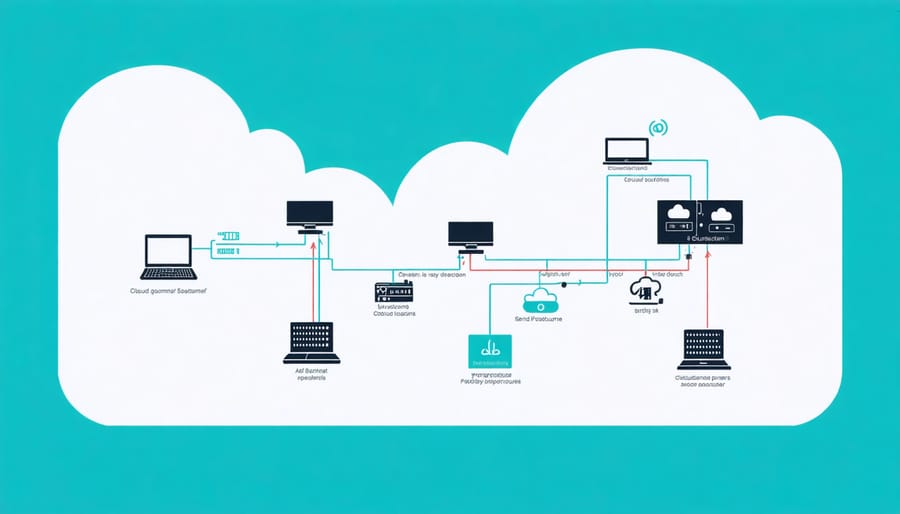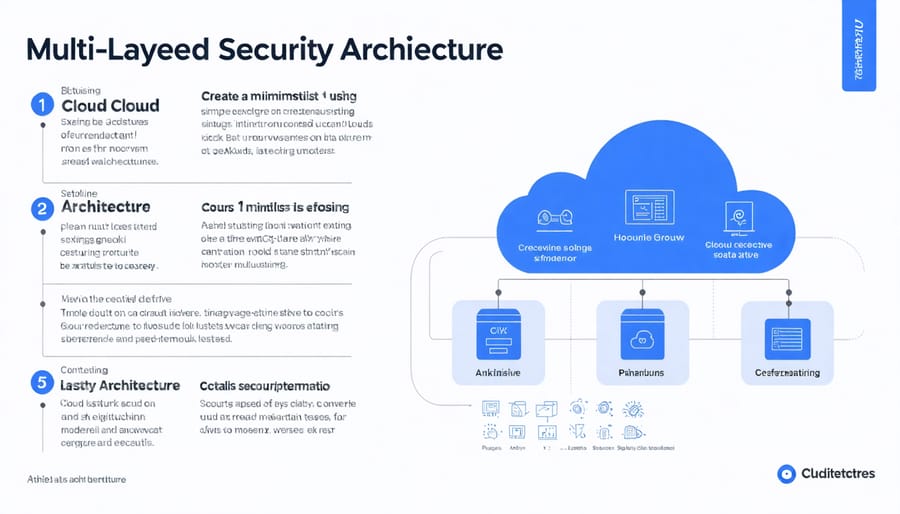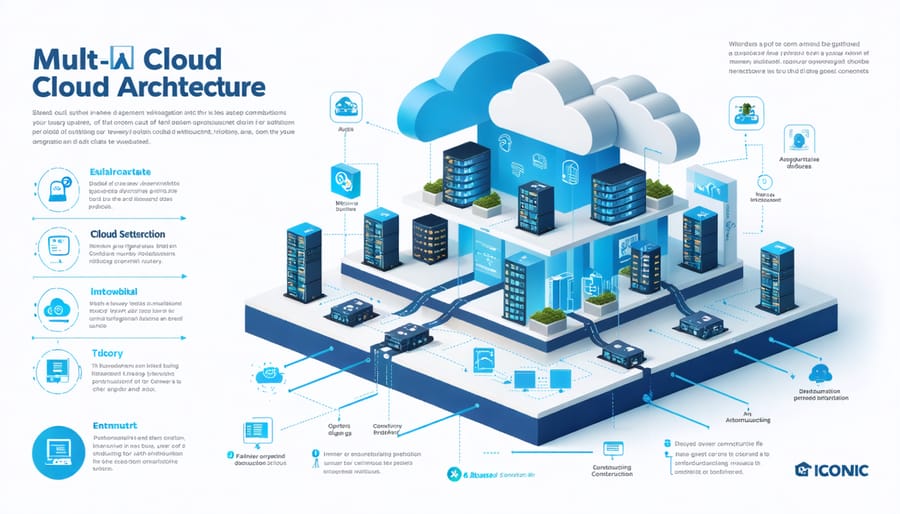Cloud resilience stands as the cornerstone of modern digital infrastructure, enabling organizations to maintain operational continuity even when faced with severe disruptions. In today’s construction and architecture landscape, where project data and critical applications must remain accessible 24/7, resilient cloud systems serve as the foundation for uninterrupted business operations.
Building resilient cloud architecture requires a strategic approach that combines redundancy, automated failover mechanisms, and distributed systems design. Just as construction professionals implement structural redundancies to ensure building integrity, cloud resilience incorporates multiple layers of protection against potential points of failure. This includes geographic distribution of data centers, real-time data replication, and intelligent load balancing systems that automatically redirect traffic when issues arise.
For construction industry leaders, understanding cloud resilience isn’t just about technology – it’s about ensuring project continuity, protecting valuable data assets, and maintaining seamless collaboration across global teams. When properly implemented, resilient cloud systems can withstand hardware failures, network outages, and even natural disasters while keeping critical construction operations running smoothly.
This comprehensive guide explores the essential components of cloud resilience, offering practical strategies for implementing robust cloud infrastructure that aligns with construction industry demands.
The Core Components of Cloud Resilience
Redundancy and High Availability
Redundancy and high availability are fundamental pillars of cloud resilience in construction IT infrastructure. By implementing redundant systems across multiple availability zones, organizations can maintain continuous operations even when primary systems fail. This approach involves deploying duplicate infrastructure components, including servers, storage systems, and network connections, across geographically distributed data centers.
In modern construction projects, where real-time collaboration and data access are crucial, high availability architectures ensure that critical applications and services remain operational. This is achieved through automated failover mechanisms that instantly redirect traffic to backup systems when issues arise. For instance, Building Information Modeling (BIM) platforms and project management systems can maintain 99.99% uptime through redundant cloud configurations.
Load balancing plays a vital role in this architecture by distributing workloads across multiple servers and preventing single points of failure. Construction firms often implement N+1 redundancy, where one additional component is added to the minimum number required for normal operation. This ensures that if one component fails, the system continues to function without interruption.
For mission-critical applications, some organizations opt for multi-region deployments, providing geographic redundancy that protects against regional outages and natural disasters. This approach is particularly valuable for international construction projects requiring constant access to project data and collaboration tools.

Fault Tolerance and Disaster Recovery
In cloud computing, fault tolerance and disaster recovery mechanisms form the backbone of resilient systems, particularly crucial for construction industry applications like BIM platforms and project management tools. Fault tolerance ensures continuous operation through redundant components and automatic failover systems, maintaining critical services even when individual components fail.
Key fault tolerance strategies include data replication across multiple availability zones, load balancing to distribute workloads, and automated health checks that detect and respond to system failures. For construction firms managing large-scale projects, these mechanisms ensure uninterrupted access to essential cloud resources and prevent costly downtime.
Disaster recovery planning encompasses comprehensive strategies for data backup, system restoration, and business continuity. Construction organizations typically implement multi-region backup solutions, maintaining synchronized copies of critical project data across geographically distributed data centers. Regular recovery testing and documented procedures ensure rapid response to major disruptions.
Industry best practices recommend maintaining Recovery Time Objectives (RTO) and Recovery Point Objectives (RPO) aligned with project requirements. For instance, mission-critical applications like structural analysis tools might require near-zero RPO, while less critical systems can tolerate longer recovery windows. This tiered approach allows organizations to optimize resource allocation while ensuring robust protection for essential services.
Building Resilient Cloud Architecture
Load Balancing and Auto-Scaling
Load balancing and auto-scaling capabilities form crucial components of cloud resilience in construction technology infrastructure. These features ensure that digital tools, building information modeling (BIM) platforms, and project management systems remain operational even during peak usage periods or unexpected surges in demand.
In construction project environments, load balancing distributes workloads across multiple computing resources, preventing any single server from becoming overwhelmed. This is particularly vital when multiple teams simultaneously access resource-intensive applications like 3D rendering software or collaborative design platforms. Modern load balancers continuously monitor server health, automatically redirecting traffic away from failing nodes to maintain system availability.
Auto-scaling complements load balancing by automatically adjusting resource capacity based on demand. For instance, during intensive design reviews or when processing large datasets from site surveys, the system can automatically provision additional computing resources. Conversely, during periods of lower activity, such as weekends or holidays, resources can be scaled down to optimize costs.
Implementation typically involves setting specific performance metrics and thresholds. These might include CPU utilization, memory usage, or the number of concurrent users. When these thresholds are breached, auto-scaling policies trigger the creation or termination of resources, ensuring optimal performance while maintaining cost efficiency.
For construction firms, these capabilities ensure that critical applications remain responsive and available, particularly during high-stakes project phases or when meeting tight deadlines.
Data Replication and Backup Strategies
Data replication and backup strategies form the foundation of cloud resilience in construction project management. Effective implementation involves maintaining multiple synchronized copies of critical project data across different geographic locations and storage systems. For construction firms managing large-scale projects, this approach ensures continuous access to crucial blueprints, BIM models, and project documentation even if one data center experiences an outage.
A robust replication strategy typically employs the 3-2-1 backup rule: maintaining three copies of data, stored on two different types of media, with one copy kept offsite. In practice, this might mean keeping primary project files in your cloud environment, a secondary copy on local servers, and an additional backup in a geographically distant data center.
Real-time replication ensures that any changes to project documentation or design files are immediately mirrored across multiple locations. This is particularly crucial for construction projects where multiple teams need simultaneous access to the latest design iterations and project updates. Automated backup systems should be configured to run at predetermined intervals, with special attention to version control for critical design documents and regulatory compliance records.
For optimal protection, implement both synchronous and asynchronous replication methods. Synchronous replication provides immediate data consistency across all locations, while asynchronous replication offers better performance over longer distances without compromising data integrity. Regular testing of backup and recovery procedures ensures that data can be restored quickly when needed, minimizing project disruptions.

Security Integration in Resilient Systems
Identity and Access Management
Identity and Access Management (IAM) serves as a critical foundation for cloud resilience in construction project environments. By implementing robust IAM protocols, organizations can maintain secure access controls while ensuring continuous availability of cloud resources. This includes role-based access control (RBAC) systems that align with project hierarchies, enabling precise permission management for different stakeholder groups – from site supervisors to BIM coordinators.
Multi-factor authentication (MFA) implementation adds an essential security layer, particularly crucial for remote access to sensitive project data and cloud-based construction management systems. When integrated with advanced threat detection and prevention mechanisms, IAM systems can effectively monitor and respond to unauthorized access attempts and potential security breaches.
Regular access audits and automated user provisioning processes ensure that cloud resources remain secure even during personnel changes or project transitions. This systematic approach to identity management supports business continuity by maintaining secure access channels during disruptions while preventing unauthorized entry points that could compromise system resilience.
Construction firms should implement least-privilege access principles, ensuring team members have exactly the permissions they need – no more, no less – to perform their roles effectively while maintaining system security.
Encryption and Compliance
In the construction industry’s digital transformation, data protection and regulatory compliance are crucial components of cloud resilience. Organizations must implement advanced encryption protocols to safeguard sensitive project data, building specifications, and client information stored in cloud environments.
Construction firms must ensure their cloud infrastructure complies with industry-specific regulations such as ISO 27001 for information security management and GDPR for data protection. This includes implementing robust access controls, regular security audits, and comprehensive data backup strategies.
Key compliance measures include:
– End-to-end encryption for data in transit and at rest
– Multi-factor authentication for accessing sensitive project information
– Regular compliance audits and documentation
– Data residency requirements for international projects
– Incident response plans for potential security breaches
For construction companies handling government contracts or critical infrastructure projects, additional security measures may be required, such as FedRAMP compliance in the United States or equivalent standards in other jurisdictions. Regular security assessments and updates to encryption protocols ensure continued protection against evolving cyber threats while maintaining operational resilience.
Monitoring and Response Systems

Performance Monitoring
Effective performance monitoring is crucial for maintaining cloud resilience in construction and architectural applications. Modern real-time monitoring systems provide comprehensive visibility into system health through key metrics such as latency, throughput, and resource utilization.
Essential monitoring metrics include system response times, error rates, resource availability, and application performance indicators. Cloud service providers offer integrated monitoring tools that track these metrics continuously, enabling quick identification of potential issues before they impact operations.
Advanced monitoring platforms incorporate predictive analytics and machine learning capabilities to detect patterns and anomalies, helping construction firms anticipate and prevent system failures. These tools often feature customizable dashboards and automated alerting systems that notify relevant team members when predefined thresholds are exceeded.
Regular performance benchmarking and trend analysis help organizations optimize their cloud infrastructure and maintain optimal service levels. This data-driven approach ensures construction projects remain on schedule by minimizing system downtime and maintaining consistent application performance.
Incident Response Protocols
Effective incident response protocols are crucial for maintaining cloud resilience in construction operations. These protocols should follow a structured approach: detection, analysis, containment, eradication, and recovery. When system failures occur, automated monitoring systems should immediately alert designated response teams while triggering predetermined failover mechanisms to maintain business continuity.
For security incidents, organizations must establish clear communication channels and escalation procedures. This includes maintaining an up-to-date contact list of key stakeholders, from IT personnel to project managers, ensuring swift response to threats that could impact construction operations or sensitive project data.
Documentation plays a vital role in incident management. Teams should maintain detailed incident logs, recording the nature of failures, response actions taken, and resolution outcomes. This information becomes invaluable for post-incident analysis and improving future response strategies.
Regular testing of these protocols through simulated incidents ensures team readiness and validates the effectiveness of response procedures. Construction firms should conduct quarterly drills, focusing on scenarios specific to their cloud infrastructure and project requirements, such as data breach responses or system recovery procedures during critical project phases.
Case Study: Real-World Implementation
In 2021, Turner Construction Company, one of North America’s largest construction management firms, implemented a comprehensive cloud resilience strategy during their $500 million healthcare facility project in Chicago. The project, spanning 1.2 million square feet, required seamless collaboration among 200+ team members and real-time access to critical building information modeling (BIM) data.
Turner’s cloud infrastructure was designed with multiple redundancy layers across three geographic regions, ensuring continuous access to project data even during regional outages. The system implemented automatic failover mechanisms with a recovery time objective (RTO) of less than 15 minutes and a recovery point objective (RPO) of under 5 minutes.
The resilience strategy was put to the test when a major storm caused widespread power outages in their primary data center. The cloud infrastructure automatically switched to secondary systems, maintaining uninterrupted access to crucial project documentation and BIM models. This prevented potential delays that could have cost an estimated $50,000 per hour in lost productivity.
Key components of their implementation included:
– Multi-region data replication
– Automated health monitoring and failover systems
– Load balancing across multiple availability zones
– Regular disaster recovery testing protocols
– Real-time data synchronization
The results were significant: 99.99% system uptime throughout the project duration, zero critical data loss incidents, and an estimated $2.3 million saved in potential delay costs. This implementation has since become a blueprint for Turner’s cloud resilience strategy across their portfolio of projects.
Cloud resilience has emerged as a critical component for construction and architecture firms navigating the digital transformation landscape. The key takeaways emphasize that successful cloud resilience requires a multi-layered approach, combining robust infrastructure design, comprehensive disaster recovery planning, and regular testing protocols. Organizations must prioritize automated failover systems, data redundancy, and geographic distribution of resources to maintain business continuity.
Looking ahead, the evolution of cloud resilience will likely focus on AI-driven predictive maintenance, enhanced security measures, and more sophisticated automation tools. Construction firms should prepare for increased integration of edge computing solutions and hybrid cloud architectures that offer greater flexibility and reliability. The growing complexity of construction projects and BIM applications will demand even more resilient cloud solutions.
To remain competitive, organizations must continuously evaluate and update their cloud resilience strategies, considering emerging technologies and evolving industry standards. Investment in staff training, regular audits of cloud infrastructure, and partnerships with reliable cloud service providers will be essential for maintaining robust and adaptable cloud environments that support the future of construction operations.

